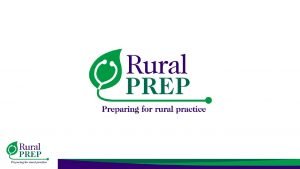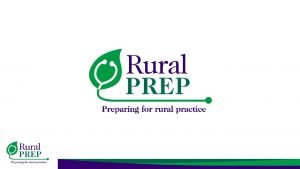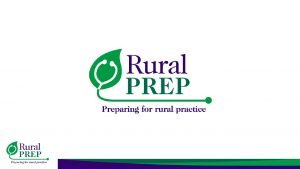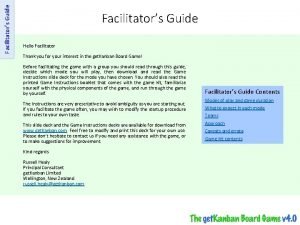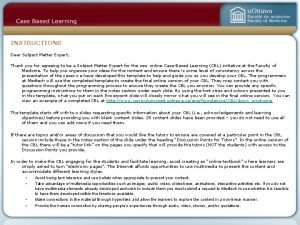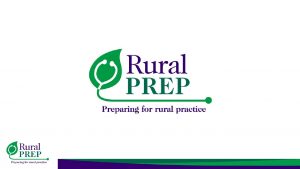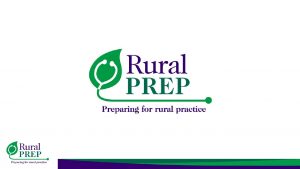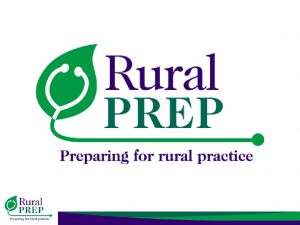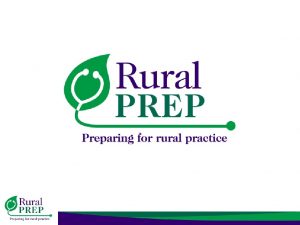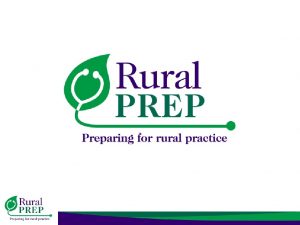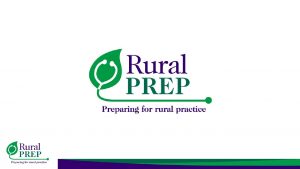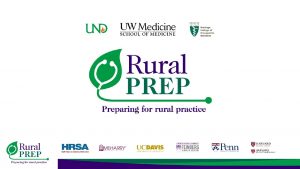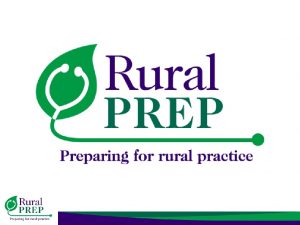A Note to Facilitators Dear Facilitator Thank you

























- Slides: 25


A Note to Facilitators Dear Facilitator, Thank you for using Rural PREP’s materials to create an active learning experience for your site. Use this slide deck, along with the Facilitator Lesson Plan, to facilitate a Grand Rounds event at your site. Many of the slides contain additional information in the presenter notes area, so be sure to review the presentation and the notes prior to your Grand Rounds event.

Session Overview • 5 minutes: Go over and discuss pre-assignment answers with the full group • 30 minutes: Watch the Presentation • 15 minutes: Facilitate the Team Activity • 5 minutes: General Discussion and Social Charge • 5 minutes: Evaluation of the Learning Materials as a group

Agricultural Exposures: organophosphate pesticide poisoning and prevention Presented by: Diane Rohlman, Ph. D Associate Professor and Endowed Chair in Rural Health and Safety, University of Iowa This presentation was originally recorded on January 24 th, 2019, in front of several live, online sites connecting from different places across the country.

Objectives After this presentation, participants will be able to: 1. Identify the signs and symptoms of acute organophosphate pesticide poisoning 2. Describe the use of cholinesterase monitoring as a possible diagnosis tool 3. Design a prevention program with regard to organophosphate poisoning for their local patient population

Team Readiness Quiz

Team Readiness Quiz 1. According to the Healthier Workforce Center’s video, Hierarchy of Controls “is organized so that the most effective changes are changes to workplace or the work environment and they don’t rely on individual behaviors. ” Therefore, in terms of promoting a safe workplace, what would be the top most priority? a. substitution b. elimination c. personal protective equipment d. engineering controls e. administrative controls

Team Readiness Quiz 1. According to the Healthier Workforce Center’s video, Hierarchy of Controls “is organized so that the most effective changes are changes to workplace or the work environment and they don’t rely on individual behaviors. ” Therefore, in terms of promoting a safe workplace, what would be the top most priority? a. substitution b. elimination c. personal protective equipment d. engineering controls e. administrative controls

Team Readiness Quiz 2. Designing work schedules to ensure equal distribution of strenuous physical work among a group of workers is an example of: a. substitution b. elimination c. personal protective equipment d. engineering controls e. administrative controls

Team Readiness Quiz 2. Designing work schedules to ensure equal distribution of strenuous physical work among a group of workers is an example of: a. substitution b. elimination c. personal protective equipment d. engineering controls e. administrative controls

Team Readiness Quiz 3. According to Fenske, Lu, Negrete, and Galvin, minimizing work-to-home transmission of pesticides is best achieved by focusing interventional activities aimed at: a. home b. commuter vehicles c. workplace d. communities

Team Readiness Quiz 3. According to Fenske, Lu, Negrete, and Galvin, minimizing work-to-home transmission of pesticides is best achieved by focusing interventional activities aimed at: a. home b. commuter vehicles c. workplace d. communities

Team Readiness Quiz 4. According to Fenske, Lu, Negrete, and Galvin, azinphosmethyl residues in vehicle and house dust were highest for which of the following worker groups? a. pesticide handlers b. fruit thinners c. organic orchard workers d. commuter vehicle drivers

Team Readiness Quiz 4. According to Fenske, Lu, Negrete, and Galvin, azinphosmethyl residues in vehicle and house dust were highest for which of the following worker groups? a. pesticide handlers b. fruit thinners c. organic orchard workers d. commuter vehicle drivers

Team Readiness Quiz 5. According to Calvert, Rodriguez, and Prado, which of the following is NOT a potential occupational hazard in agriculture: a. off-target pesticide drift b. toxicity of recently marketed pesticides c. gap in worker notification requirements d. personal protective equipment (PPE)

Team Readiness Quiz 5. According to Calvert, Rodriguez, and Prado, which of the following is NOT a potential occupational hazard in agriculture: a. off-target pesticide drift b. toxicity of recently marketed pesticides c. gap in worker notification requirements d. personal protective equipment (PPE)

Team Readiness Quiz 6. According to Calvert, Rodriguez, and Prado, the most common cause of acute pesticide-related illness among farmworkers is: a. off-target drift from neighboring farms/orchards b. commuter vehicles c. inadequate hand washing d. work-to-home transmission

Team Readiness Quiz 6. According to Calvert, Rodriguez, and Prado, the most common cause of acute pesticide-related illness among farmworkers is: a. off-target drift from neighboring farms/orchards b. commuter vehicles c. inadequate hand washing d. work-to-home transmission

Agricultural Exposures: organophosphate pesticide poisoning and prevention Rural PREP Grand Rounds Presenter: Diane Rohlman, Ph. D Associate Professor and Endowed Chair in Rural Health and Safety, University of Iowa Launch the Presentation Now

Team Activity

Team Activity What if you were to design a prevention program with regard to organophosphate poisoning for your local patient population? What local resources would you turn to? In answering this question as a team, you may wish to consult the • National Pesticide Information Center: http: //npic. orst. edu/index. html • Migrant Clinicians Network Map: https: //www. migrantclinician. org/issues/occupationalhealth/pesticides/reporting-illnesses • NIOSH Centers for Agricultural Safety and Health https: //www. cdc. gov/niosh/oep/agctrhom. html

Discussion

Social Charge What are you personally going to do with this information?

Evaluation Please evaluate these learning materials as a group: https: //goo. gl/forms/uh. TYt. ZEMHCX 74 tm 72

 Thank you message to facilitator
Thank you message to facilitator Thank you message for the facilitator
Thank you message for the facilitator Thank you note for facilitator
Thank you note for facilitator Thank you letter to workshop facilitator
Thank you letter to workshop facilitator Thank you for your facilitation
Thank you for your facilitation Thank you facilitator
Thank you facilitator Dear jane thank you for your letter
Dear jane thank you for your letter Welcome dear students images
Welcome dear students images Sorry i haven't written sooner
Sorry i haven't written sooner How to thank a training facilitator
How to thank a training facilitator Virginia equity math
Virginia equity math Promotion industry
Promotion industry External facilitators advertising
External facilitators advertising Thank you note to subject matter expert
Thank you note to subject matter expert Thank you note to building superintendent
Thank you note to building superintendent Thank you judges
Thank you judges Preceptor
Preceptor Thank you note to preceptor after orientation
Thank you note to preceptor after orientation Thank you for your listening!
Thank you for your listening! The darling of heaven crucified
The darling of heaven crucified 主耶稣我感谢你
主耶稣我感谢你 Any question thank you
Any question thank you Difference between note making and note taking
Difference between note making and note taking Signal words
Signal words Difference between note making and note taking
Difference between note making and note taking Goods received note
Goods received note
